About the Art Component
Art can communicate scientific concepts. Such communication enhances public and political support for science. Artists and scientists working together can add breadth and depth to both. At this year’s conference, we have art springing from such collaborations. The lunchtime panel will discuss the experience of fusing art and science, especially in education.
- Morning of September 10: A short presentation at the end of the plenary session
- Lunchtime September 11: A panel discussion (see below for more information)
- Poster Sessions September 10,11: Art and Science exhibitors (see below for more information)
- Concurrent Sessions Sept 11: Art-related sessions during the general sessions (see below for more information)
Lunchtime Discussion
Lunchtime Panel Discussion, Room 315
September 11, 12:20-1:20 PM
This panel will discuss the experience of fusing art and science, especially in education.
Art and Science Exhibitors
Join the artists and scientists at the poster reception, 5:15-7:15 p.m. on September 10 and 11.
Tamar Assaf, Artist
Dr. Anna Sturrock, UC Davis
Hanging by a Thread. A short documentary
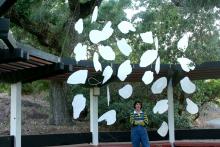 Manmade structures built to capture, transport and reallocate water can transform natural, diverse and seasonally variable systems into constant, simplified bodies of water, denying salmon the natural conditions necessary to grow and thrive, and impeding their ability to evolve and persist in a changing climate.
Manmade structures built to capture, transport and reallocate water can transform natural, diverse and seasonally variable systems into constant, simplified bodies of water, denying salmon the natural conditions necessary to grow and thrive, and impeding their ability to evolve and persist in a changing climate.
By measuring the growth rings on otoliths (fish earstones) through a microscope and analyzing their chemical composition across life stages, Dr. Anna Sturrock tracks salmon movement patterns and growth rates, and identifies the aquatic conditions experienced during their freshwater residence. By reconstructing this information in juveniles and in the limited number of survivors returning to spawn, she attempts to track the conditions and behaviors that allowed the fish to complete their natural life cycle despite the many obstacles.
Tamar Assaf’s sculpture installation is inspired by Dr. Sturrock’s research – translucent ‘otolith slides’ hovering over ghost salmon.
The fishing rods reference traditional, simpler way of life and fishing methods. Bamboo was chosen to represent a renewable resource. The fish are metal outlines of faint ghosts hovering at the end of their ropes. The rusty steel, like the survivors coming back to spawn, their bodies disintegrate as they care for the next generation.
The light and airy installation allows only limited movement of the endangered salmon which, like in the Bay-Delta system, are hanging by a thread.
For more information about the artist, visit www.tamarassaf.com
To watch a video about this project, click here.
Dr. Dylan Chapple, scientist, educator, musician and sound artist
Elia Vargas Visual, artist and curator, Ph.D. candidate
Ryan Huber Musician, sound artist, and educator
sub-Tidal
sub-Tidal is an interactive sound/video piece. Audio, images, and quantdata content are taken from the Mayberry Wetland Restoration Project in California’s Delta. The source material for the project is taken from 3 distinct sources collected at the Mayberry Wetland Restoration Project in California’s Delta: 1) Time-lapse photographs over three years of restoration efforts; 2) A quantitative gas exchange and other environmental data collected as part of the global FluxNet data network by the Baldocchi Lab Group at UC Berkeley; 3) Field recordings taken of habitats above and below water at the site in January of 2016. These elements are aggregated using MaxMSP software to create an audio/visual environment that brings the audience into a space where human and natural systems meet. Across 5 small screens, time-lapse photographs illustrate the expansion and seasonal changes in vegetation, code processes quantative FluxNet data to visualize changes in color and hue that correspond to shifts in environmental conditions at the site. Parallel code uses the FluxNet data to create a time-synced musical score based on sounds from a dawn chorus at the site. Participants will be able to interact with the speed of the time-lapse, allowing for detailed exploration of how conditions change throughout the restoration process. As a simple, approachable model of the complex stochastic processes that drive wetland development, sub-Tidal helps illuminate multiple dimensions of how ecosystems change over time.
Dan Constable, Delta Stewardship Council
Cory Copeland, Delta Stewardship Council
River hydrology and Bay inflow in California is characterized by high inter- and intra-annual variability. In addition, changes to water management have resulted in large changes to inflows and outflows to the Bay-Delta system. This project will create a series of 2-4 panels demonstrating historic and recent wet and dry year flows through the Delta, based on the Eight-River Index and historic average and future climate projections from CalAdapt. Recent work leveraging data analysis tools allows this to be analyzed and communicated using open source computer programs and scripts. Analysis will be performed using these computer-aided methods, and outputs will be transferred to traditional medium.
Dan Constable, Delta Stewardship Council
Ron Melcer, Delta Stewardship Council
Low gradient rivers typically are characterized by meandering, multi-channel forms that are highly dynamic. Tributaries to the Bay-Delta, such as the Sacramento and San Joaquin rivers, historically followed these patterns. However, over time these rivers have been straightened and held in place by a system of ‘armored’ levees. This piece aims to recreate similar work done on the Mississippi River to illustrate change in river channel form over time using lines and color. Anticipate sketching the upper and middle Sacramento River; potentially will include the San Joaquin River depending on historic data availability.
Isabella Millet, The Athenian School
Dr. Gabrielle Boisrame, Delta Science Program
In the details of our everyday life; brushing our teeth, cooking, washing our hands, it is easy to forget the incredible beauty of California's diverse and expansive watersheds that provide the water we so desperately need and depend on. It is easy to call to mind images of cement walled rivers, or neat lines on an aerial view of the Delta, but harder to make peace with the wild rivers of the Sierra, the rapids on the American river, the bears and wildcats that live and hunt by the same water that might end up in our showers. Isabella Millet, a high school senior at The Athenian School spent her summer backpacking in the Sierra and exploring the rivers and lakes of California. Isabella worked with Gabrielle Boisramé, an environmental scientist at Delta Stewardship Council, to create this piece, which aims to connect the wild source and the privilege of clean and reliable water in our homes and cities. When Isabella began this project, she, like so many other Californians who depend on the Delta, had almost no knowledge of its complexities, its history, or the origin of the water that flows through it. Her work with Gabrielle helped her collect knowledge about the Delta, and form a basic understanding of the water systems that flow throughout California. This piece steps back to observe and present the connection between Sierra watersheds and the California Delta and water systems. The piece is spread across three canvases, disconnected, yet dependent on each other to complete itself. The background is a representation of a Sierra watershed, ambiguous and abstracted enough to be any of the magnificent lakes that feed the Delta, inclusive and admiring yet uninformed in its portrayal. Over this is stretched a partial map of the Delta, which leads to a maps of California’s major cities, allowing the Delta to be the connector between these aspects of life and survival in California.
Emerson Gusto, USGS
My background as an artist started when I was in the U.S. Navy as an Illustrator-Draftsman. I created original art, technical illustrations, and computer graphics for briefings, visual training aids, and publications. When I left the service, I got a job as a manager and lead computer graphic designer at a printing shop. I was in charge of creating all computer graphic designs for posters, signs, and t-shirt silkscreen prints.
I always admired the work of Norman Rockwell. I draw with pencil and pen in my sketchbook. I also paint and recently discovered I enjoy using the “finger painting” technique. My inspirations are from the works of Chuck Close, who is famous for highly inventive techniques of painting the human face, and Pablo Picasso’s monochromatic Blue Period.
My proposal for the 10th Biennial Bay-Delta Science Conference Art Exhibition is to create an acrylic “finger painting” of the Liberty Island Conservation Bank. The Bank is a sculpted and restored network of tidal channels located in the southern Yolo Bypass in Yolo County, Ca. It provides habitat for many native fish species including Chinook salmon, Steelhead, Delta Smelt, Sacramento Pikeminnow/Splittail/Sucker, Prickly Sculpin, Tule Perch, and Hitch.
Jane Hartman, Artist
Neil Hartman, FDA
Nitrogen: Nasty or Necessary? A Narrative in Glass
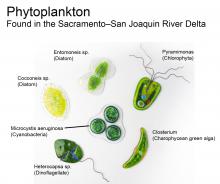 In an estuary, the amounts and forms of nutrients are thought to affect phytoplankton communities. Changes to phytoplankton communities may cause cascading effects all the way up the food web, as has been observed in the Sacramento-San Joaquin Delta. Jane will visually express the hypothesized correlation between the amount of NH4 and NO3 and the corresponding abundances of phytoplankton (eg diatoms, flagellates, cyanobacteria) found in the Sacramento-San Joaquin Delta. She will also show some of the impacts further up the food chain (eg copepods, etc.). She will collaborate, as needed, with specialists, so that her depiction is accurate, while still also making it visually appealing.
In an estuary, the amounts and forms of nutrients are thought to affect phytoplankton communities. Changes to phytoplankton communities may cause cascading effects all the way up the food web, as has been observed in the Sacramento-San Joaquin Delta. Jane will visually express the hypothesized correlation between the amount of NH4 and NO3 and the corresponding abundances of phytoplankton (eg diatoms, flagellates, cyanobacteria) found in the Sacramento-San Joaquin Delta. She will also show some of the impacts further up the food chain (eg copepods, etc.). She will collaborate, as needed, with specialists, so that her depiction is accurate, while still also making it visually appealing.
The NH4 and NO3 molecules created will be scientifically accurate and created using the “Lost 3D Printed Plastic Technique” (adapted, by Jane, from the “Lost Wax Technique” used in jewelry and bronze casting): Molecules are computer designed by her collaborator, Neil Hartman and 3D printed with plastic. Molds are then created from these plastic models by encasing them in plaster and then melting out the plastic. The molds are then used to cast the molecule in glass.
Jane Hartman is a full-time glass artist whose formal education was in science (zoology, geology, paleontology). She specializes in science art with special emphasis in the biology. She takes particular joy in collaborating with scientists so that the end result is both aesthetically pleasing and scientifically accurate.
Neil Hartman is a research pharmacologist (FDA) who in his spare time designs space-filling molecular models (among many other nerdy objects) to 3D print.
Dr. Rosemary Hartman, CDFW
Fish are slippery creatures. Getting accurate estimates of population sizes is difficult (pretty much impossible). Most population indices and estimates are based on models extrapolated from the catch of fish in nets or trawls. However, these models often assume fish are evenly distributed in the water column, all fish have an equal likelihood of being caught in the net, and fish do not actively avoid the net. To call attention to the problems inherent in these assumptions, Rosemary will create an art piece made of many stained glass fish suncatchers, some of which will be “caught” in a net made out of actual research netting material. Other fish will be fleeing from the net or escaping through holes in the net. All the fish will be species found with the Sacramento-San Joaquin Delta.
Rosemary is a senior environmental scientist with CDFW’s Fish Restoration Program, and she also creates stained glass art in my spare time. She loves using glass as a medium for showing others the beauty of the natural world, especially the under-appreciated native fish of California.
Lisa Jetonne, Artist
Dr. Kristin Byrd, USGS
Do You Dare Disturb The Universe?
Do You Dare Disturb The Universe? employs maps of Dr. Byrd’s wetland research areas, each map laser cut into the typical birch panel used by painters; each panel mounted on a gimbal. The gimbal can be controlled by levers under the panel; a threshold weight of paint also triggers gimbal movement. Participants paint over/into the laser cut map, employing pipettes and droppers (instead of brushes and knives), with a palette of highly fluid paints of varying specific gravity. Additional changes can be made by adjusting the levers to provoke paint flow. Solid paint additives can also be included, to affect the direction, shape, and flow of the paints and pigments. Despite any alterations in appearance by the painting process, the depth of laser-cut wood helps direct maintain the integrity of the map. Overflow falls into a catch tray under each painting panel. Fresh map panels will be offered each day of the conference, and the number of participants tracked and recorded for each map. One minute and three-minute hourglass timers are suspended over the painting table: any onlooker wishing to participate when the painting table is fully occupied can start a timer (one minute for an individual participant; three minutes for a group making painting decisions) to prevent any monopolizing of the decision-making.
Artist Lisa Jetonne creates collaborative art projects to engage audiences and participants in the dynamics of decision-making.
For more information about this project, click here.
Graham Keeble, Artist
Alex Keeble-Toll, Sierra Fund
As a sculptor I rely on the unique qualities of salvaged, reclaimed and re-purposed materials. I allow these materials to inspire and shape my sculptures. This gives each of my pieces individuality and a history that cannot be duplicated. My work not only highlights sustainability but also the resiliency and strength, both of the materials I use and the subject matter.
My work is predominantly process based so at the beginning of a piece I don’t have an outcome in mind. I find a starting place in a piece of wood or metal I find that lends its self to something else. From there I treat each piece like a free form three‐dimensional jigsaw puzzle. My collections of salvaged and recycled materials are my puzzle pieces and what the finished product will be comes to me somewhere along the way.
For more information on the artist, please visit http://www.grahamkeeblesculpture.net.
Soojin Kim, Environmental Defense Fund
Dan Constable, Delta Stewardship Council
Sometimes language – scientific or otherwise – cannot capture and communicate an idea succinctly. This is also true when translating between languages. This project will present a series of Korean alphabet characters (‘Hangul’) that represent ideas relevant to aquatic systems that cannot be easily translated into English. Characters will be modified to form part of a picture. For example, ‘the movement of melting [snow]’, ‘fluttering [salmon] fish’, and ‘the sound of waves crashing’ [in the Bay].
Sarah Misra, Artist
Harry Spanglet, DWR
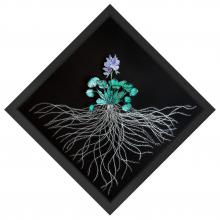 The Bay-Delta ecosystem is one of the world’s most capricious places, with unpredictable cycles of extreme floods and drought; it is also the most human-altered estuary in the world, plagued by pollution, land subsidence, invasive species, and changing climate. Species in this challenging environment will have to adapt through natural selection or fare poorly. In light of human interests, and with the aid of modern genetic engineering, perhaps humans can also intervene.
The Bay-Delta ecosystem is one of the world’s most capricious places, with unpredictable cycles of extreme floods and drought; it is also the most human-altered estuary in the world, plagued by pollution, land subsidence, invasive species, and changing climate. Species in this challenging environment will have to adapt through natural selection or fare poorly. In light of human interests, and with the aid of modern genetic engineering, perhaps humans can also intervene.
We will reimagine possible versions of existing plant species from the Bay-Delta as three-dimensional mixed media collages that are conceptually based on scientific principles, with the inspiration of how species could be genetically engineered to better cope with a changed environment, or to serve an ecological benefit, such as:
- Water hyacinth, an invasive aquatic weed and a plague of the Delta, is engineered to bioconcentrate methylmercury from surrounding water and efficiently cleanse the water of this toxin. Through a quirk of biochemistry, the mercury accumulates in a non-reactive elemental form in the flowers that imparts a distinct metallic sheen.
- Tules, cattails, cottonwood, and willow are the defining face of the Delta, and are reliant on wind for pollination and seed dispersal. We envision plants that are engineered to supplement their pollination potential by growing a diversity of fantastic flowers and fruits that attract bees, bats, or birds.
As scientists face the realities of a deteriorating environment and of realistic genetic manipulation of whole organisms, these imagined species raise ethical questions of what could be vs. what should be done to fix our problems - and where (if anywhere) that line is drawn. Our mutants are presented as an imaginative act, to inspire consideration of the possibility of such drastic human interventions in a foreseeable future.
Sarah is an artist based in San Francisco, and her current body of work explores ideas of vanishing species and imagined new hybrid plants.
For more information on the artist, please visit www.sarahmisra.com.
Daniel Nylen, American Rivers
Central Valley Multi-Benefit Flood Management Storymap Interactive Display: I am a scientist and artist. I work for American Rivers, advancing floodplain restoration projects along the Sacramento and San Joaquin rivers. I am also a photographer. I have developed an ESRI Storymap using mostly aerial imagery I took during the 2016-17 winter/spring that highlights the work we do, which can be described as multi-benefit flood management. The artwork consists of displaying the Storymap on a large monitor/screen so that the audience can interactively scroll through the Storymap in person and see the imagery on a large screen.
For more information on the artist, please visit www.danielnylenphoto.com.
Laura Rivera, Artist, UC Davis
Katherine Perkins, Sacramento Water Forum
Jessica Kathan, USGS
Embodied Aerials
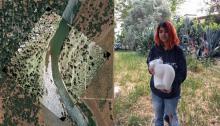 The installation consists of plaster casts of a Venus figure (female torso) positioned with spawning gravel from the lower American River, a piece of wood engraved with a poem, and one figure paper mâchéed with aerial photographs of Chinook salmon redds in the lower American River. The casts were made using a mold found at a salvage yard in the Bay Area, signed by deceased sculptor, Scott Amour. These Venus figures serve as a representation of death and creation fitting to the subject matter of the piece in its entirety: like the nests salmon construct from gravel, the figures are simultaneously fertility symbols and grave stones for returning salmon completing their life cycle. The piece relates to the science and ecology of the San Francisco Bay Delta Estuary in that it is both a representation of a key life stage of an important Delta species and a depiction of a method used to monitor the species.
The installation consists of plaster casts of a Venus figure (female torso) positioned with spawning gravel from the lower American River, a piece of wood engraved with a poem, and one figure paper mâchéed with aerial photographs of Chinook salmon redds in the lower American River. The casts were made using a mold found at a salvage yard in the Bay Area, signed by deceased sculptor, Scott Amour. These Venus figures serve as a representation of death and creation fitting to the subject matter of the piece in its entirety: like the nests salmon construct from gravel, the figures are simultaneously fertility symbols and grave stones for returning salmon completing their life cycle. The piece relates to the science and ecology of the San Francisco Bay Delta Estuary in that it is both a representation of a key life stage of an important Delta species and a depiction of a method used to monitor the species.
Laura Rivera is an artist and undergraduate student at UC Davis. She specializes in sculpture and mixed media art. Kat Perkins is a CivicSpark Americorps fellow at the Sacramento Water Forum, where she is developing and implementing a method for conducting redds surveys using aerial photography and GIS. Jessie Kathan is conducting fish ecology and food web research as a Biological Science Technician with the Aquatic Ecology Group at USGS, focusing on native fishes in the North Delta. The artist-scientist trio shared a common habitat at the UC Davis housing co-operatives.
Anne Rosenthal, Multimedia Science Writer
Lookout
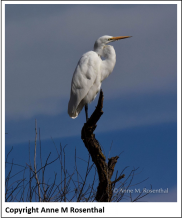 This photograph of a majestic Great Egret (Ardea alba) was taken at the Yolo Bypass in the Sacramento Valley. The photograph captures the value of Delta snags as lookout posts.
This photograph of a majestic Great Egret (Ardea alba) was taken at the Yolo Bypass in the Sacramento Valley. The photograph captures the value of Delta snags as lookout posts.
Anne M. Rosenthal is a multimedia science writer based in the San Francisco Bay Area. She holds BS and MS degrees in Biological Sciences from Stanford University and a Certificate in Technical Writing from San Jose State University.
Anne was an intern in science writing at California Academy of Sciences under Keith Howell, editor of Pacific Discovery and California Wild. She served as editor of Jasper Ridge Views, a newsletter of Stanford University’s Jasper Ridge Biological Preserve, for nine years. Anne has written for the US Forest Service Albany Research Station, Scientific American on-line, Stanford Medicine, California Wild (California Academy of Sciences), and NASA’s Astrobiology Magazine, among others. Her photography has appeared on the cover of the Jasper Ridge Annual Report.
Currently focused on ecosystem complexity, Anne is working on a multimedia book, Nature Nearby. (Nature-Nearby.com is the website for the book in progress.) She especially enjoys photographing flower fly (Syrphidae) bee, wasp, and yellow jacket mimics, as well as butterflies. All of Anne’s photos are taken in the field, mostly using natural light, with an emphasis in showing the relationships between organisms and habitat, as well as life history and behavior. NatureNearby.Zenfolio.com displays a selection of Anne’s work over the past eight years.
Photography and video are interesting media – they not only help document what you see, but they help you to see more. Anne is interested in working with scientists, managers, and volunteers to document and explore natural history and scientific and environmental work related to the San Francisco Bay Area and the Delta. She welcomes you to contact her at GreatEgret2018@gmail.com.
Dr. AnneMarie Schleiner, Lecturer in Design, UC Davis
Shadow River is a game still in prototype stage inspired by Minimalist landscape art, Meso-american astroarchitecture, and the bends of a California creek at time of climate change, drought and weather imbalance. In this Game for Change, intended to be a conversation starter about the Anthropocene, the players' mission is to navigate a life raft to safety. The boat can only move when a tree cast long shadows over the dry creek bed and the player uses a time mana rock to freeze and reverse the movement of the sun. Upon completion, this game is intended to be a tabletop augmented reality game using markers and mobile devices like tablets or phones.
For a sample, visit https://drive.google.com/file/d/14r-p4ncrcYoQVpzXuZC-OhQUbJu2Hoqe/view.
Art-related sessions
What Difference Does it Make? The Practice of Art and Ecology in Collaboration
Carol Maxwell, AECOM
Tuesday, September 11, 1:35–3:15pm, Room 315
Through the exploration of five artist’s work, this session will explore moments when art and environmental science come together to uniquely enhance awareness or spark breakthroughs in reaching new audiences for an environmental cause. The group will explore where conflicts arise between the two disciplines, experiences that have contributed to an interdisciplinary approach, and potential paths forward.
Carol Maxwell (1:35) is an ecologist and landscape designer working to facilitate communication at the interface between restoration science and practice. Lisa Schonberg (1:55), a composer, and percussionist, documents habitats and soundscapes to drawing attention to endangered species and habitat loss. Kristina Dutton (2:15) is the founder of Creek College and a violinist/composer, moving freely between improvisation and interdisciplinary collaboration. Melody Owen (2:35) is a conceptual artist and curator working in collage, video and virtual worlds. Elise Brewster (2:55) is a sculptor and founding instigator for the Historical Ecology Program of the SFEI.
From Paper to Screen: The Intersection of Emergent Science and Cultural Awareness
Lauren Muscatine, UC Davis
Enid Baxter Ryce, CSU Monterey Bay
Tuesday, September 11, 3:35–5:15pm, Room 315
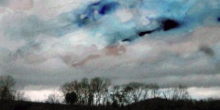 A series of extratropical rainstorms called atmospheric rivers attracted public attention during the wet seasons of 2016/17 and 2017/18. During this period, while recognizing the need to describe the foundational work on this topic, a global team of researchers and editorial team began to write the foundational book, Atmospheric Rivers.
A series of extratropical rainstorms called atmospheric rivers attracted public attention during the wet seasons of 2016/17 and 2017/18. During this period, while recognizing the need to describe the foundational work on this topic, a global team of researchers and editorial team began to write the foundational book, Atmospheric Rivers.
Lauren Muscatine,managing editor for the book, describes the development of this weather pattern, which is now technically defined and broadly researched and available in the open literature. Enid Baxter Ryce explores atmospheric rivers and what effects they have on humans and society in her new film, War and the Weather. In her portrayal and discussion, she describes how atmospheric rivers capture the human imagination, how society evaluates and gauges global weather patterns, their causes, and their impact on the environment. After a discussion of the science behind the book’s development and a screening of the film there will be time for an interactive Q&A with both creators.
